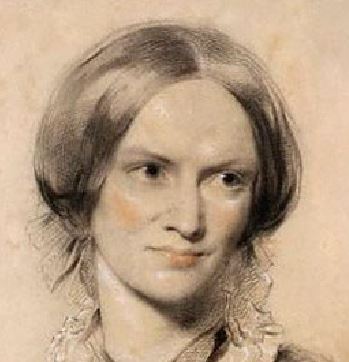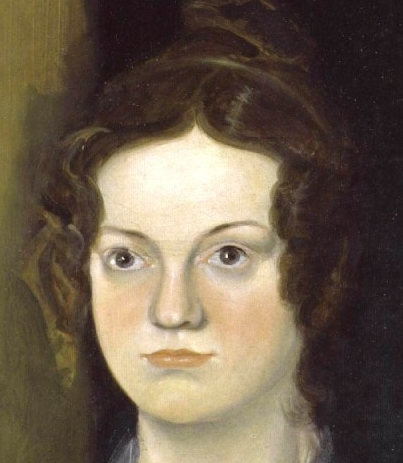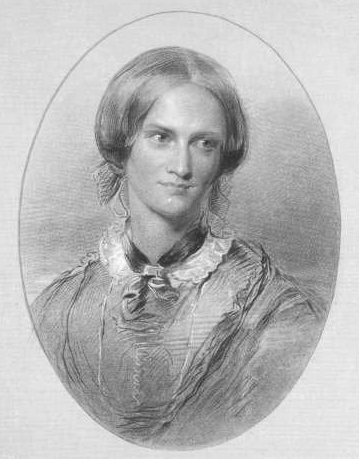| |
Charlotte Bronte's Two Portraits
|
|
Two very different portraits of Charlotte Bronte exist. George Richmond's
(1850) remained hidden from public view but was published as an engraving in 1857. After the
death of Charlotte's widower in 1906 the original portrait passed to the National Portrait Gallery.
It was first exhibited in 1907 by which time it
had become firmly established as the public image of Charlotte.
In 1914 it was discovered that Charlotte's widower had hidden away a second
portrait. This was an 1830s group portrait of the sisters by their brother Branwell,
but Charlotte's appearance in this portrait was very different.1.
|
|
1850 - George
Richmond
|
|

Detail from George Richmond's portrait of Charlotte.
National Portrait
Gallery, London NPG 1452
After the death of her siblings, Charlotte's publisher requested portraits of
them but she replied that there were none. There were sketches and watercolours she had made of her
sisters, also Branwell's two group portraits, but she probably considered these
unworthy of publication. Another influence could have been the well documented fact that
Charlotte was very self-conscious about her own appearance. Shortly after this she travelled
to London and her publisher George Smith paid for the well-known society artist, George Richmond,
to create her now famous portrait.
 |

|
|
Anne Bronte (left) and
Charlotte (right) in the 1830s group 'Pillar Portrait' by their
brother, Branwell.
|
When Charlotte first viewed the completed portrait she burst into tears because
it reminded her so much of her sister Anne who had died the previous year. Looking at portraits of
Anne it is clear why; she had an oval face and a Roman nose. George Smith asked if he could have a
copy made for himself, presumably for future publication.
When the portrait arrived at Haworth Parsonage there were mixed
views, on 2nd August 1850 Patrick Bronte wrote:
"The two portraits have, at length safely arrived, and have been as
safely hung up, in the best light and most favourable position. Without flattery the artist, in
the portrait of my daughter, has fully proved that the fame which he has acquired has been
fairly earned. Without ostentatious display, with admirable tact and delicacy, he has produced
a correct likeness, and succeeded in a graphic representation of mind as well as matter, and
with only black and white has given prominence and seeming life, and speech, and motion. I may
be partial, and perhaps somewhat enthusiastic, in this case, but in looking on the picture,
which improves upon acquaintance, as all real works of art do, I fancy I see strong indications
of the genius of the author of 'Shirley' and 'Jane Eyre'."
The portrait was a generous gift for Charlotte's father and this is
a letter thanking George Smith. Charlotte certainly seems to have been delighted with the
portrait.
When Charlotte died in 1855 there were no published portraits of her
or her family in the public domain and when it was suggested that one should
be used to illustrate her biography, her widower was opposed to the idea.
1a.
|
|
1857 - J
C Armytage
|
|
Publication of George Richmond's Portrait of Charlotte Bronte as an
engraving.

Engraving by Armytage of George Richmond's portrait of Charlotte,
1857.
Pressure was applied to Arthur Nicholls and he eventually he relented.
Charlotte's portrait was photographed, an engraving was made and it appeared in the biography
(1857). Here, Elizabeth Gaskell commented on this portrait and Branwell's group portrait of the
sisters.
She considered George Richmond's portrait to be "an admirable
likeness" but this is ambiguous, it could mean
"an admirable resemblance" or
"an admirable portrait." When
read in context it can only mean the latter because she then states that "those closest to
Charlotte" were "least satisfied with the resemblance" before going on to
praise Branwell's portrait.
She describes Branwell's 'Pillar Portrait' of his sisters as a poor painting but
was surprised by "...the striking resemblance which Charlotte ...
bore to her own representation, though it must have been ten years and more since the
portraits were taken. They were good likenesses, however badly
executed.” Charlotte would have been standing next to the portrait when Mrs
Gaskell viewed it in 1853 and these remarks imply that her appearance had changed very little in
twenty years.2.
The careful wording is perhaps partly due to Charlotte's widower
and the fact that Elizabeth Gaskell's publisher was George Smith, the man who had commissioned
the portrait seven years earlier. The pictures could easily depict two different women. If Gaskell
was correct then Branwell's oil painting is a poor portrait but the resemblance is good; Richmond's
is a good portrait but the resemblance is poor.
 |
 |
|
LEFT: Charlotte with an oval face and convex nose in
George Richmond's
portrait. RIGHT: Charlotte
with a square face and straight or concave nose in Branwell's 'Pillar Portrait'
|
When Arthur Nicholls Initially withheld permission to publish the portrait,
Ellen Nussey, in a letter to Elizabeth Gaskell, wrote that "there would always have been regret
for its painful expression to be perpetuated." A friend of Charlotte, Laetitia Wheelwright,
thought the portrait was "entirely flattering." Charlotte's
close friend, Mary Taylor, criticised the publication of a "flattered
likeness" lacking "the veritable square face" and
the "large, disproportionate nose." 3.
Mrs Pitt Byrne on George Richmond in general, and Charlotte's portrait:
"No one perhaps ever succeeded in that marvellous idealisation of a
sitter as George Richmond; he sets before him a man and lo! He makes him a poem, and what is
more inexplicable is that rare genius of his...there is no want of truthfulness to
nature. I don't know nor do I care whether he copies the features - between
ourselves I don't believe he does - but what of that? He gives you the mind, character, the
inner-self of his sitter, and always with a facile grace, which while it transfigures the
subject, still faithfully reproduces him... An example of this can be seen in the
pleasing portrait of Charlotte Bronte which he drew... with the bright eyes and charming
expression illuminating features that would otherwise have been
plain." 4.
In 1858, John Ruskin commented on his own portrait by George Richmond:
"You know I quite agree with the Daily News about the portrait. in fact,
I don't consider it a portrait at all, but merely a pleasant fancy of me by George
Richmond."
George Richmond painted "the truth, lovingly told" but Branwell
Bronte tried to achieve a true likeness.
|
|
John Hunter
Thompson.
|
|
It is clear by the comments made by Charlotte's friends that her portrait by
George Richmond is idealised and this is why it has not been used to compare with 'Charlotte' in
the photograph. There are many variations of the portrait but the first was the engraving by
Armytage (1857) for Smith, Elder.
|

J C Armytage's engraving
(reversed)
|

John Hunter Thompson's portrait of
Charlotte.
|
Charlotte's vibrant portrait by John Hunter Thompson is based on the engraving
by Armytage (there is a faint horizon line which does not exist in the original). Thompson may
have worked from a collodion photograph of the engraving as these were usually reversed images;
Charlotte's slightly crooked mouth turns down on the wrong side and her hair is parted on the wrong
side.
|
|
RETURN TO CONFUSING
PORTRAITS INDEX
|
|
|
|
|
1. George Richmond was interested in
physiognomy, as was Charlotte. In this extract from The Professor (a novel based
upon Charlotte's experiences in Brussels) she describes Frances Evans Henri: "You cannot tell
whether her nose was aquiline or retrousse, whether her chin was long or short, her face square or
oval; nor could I the first day, and it is not my intention to communicate to you at once a
knowledge I myself gained by little and little."
Charlotte
describing Frances Evans Henri in chapter 14 of The Professor (written in 1846 but unpublished;
edited & published posthumously in 1857).
1a. Barnard; Louise Barnard (29 March 2013).
"Brontë, Patrick Branwell". A Brontë Encyclopedia. Wiley.
p.263
"Most commentators agreed on the excellence of the
likenesses, despite the crudeness of Branwell’s artistic
techniques."
Ann Dinsdale, Brontë Parsonage Museum collections manager.
Keighley News 30 July 2015.
"Branwell’s famous portrait which is believed to show
a good likeness to the real-life Charlotte, Anne and
Emily."
2. There is other evidence that
Branwell managed to achieve a good likeness.
He had a brief career as an artist in Bradford from June
1838 until May 1839 lodging with the Kirby family and their niece, Margaret Hartley. In 1893 she
reminisced that “Whilst lodging with us he painted
my portrait and those of my uncle and aunt, and all three were accounted good
likenesses.” In 1858 William Davies visited Haworth
Parsonage, spoke at length with the Rev Patrick Bronte and on leaving was shown Branwell's
'Gun-Group' portrait of his sisters: “It was crude and
harsh from a technical point of view but the likenesses were said to be
good”
3. Letter from Mary Taylor to Mrs
Gaskell, 30th July 1857, Charlotte Bronte and Her Circle, Clement K. Shorter, 1896.
P.22
4. Gossip of the Century; Personal
and Traditional Memories - social, Literary, Artistic, &c Published in 4 Volumes by Mrs. Wm.
Pitt Byrne, 1892. Quoted by Mark Bostridge in 'CHARLOTTE BRONTE AND GEORGE RICHMOND -
Idealisation in the sitter' Bronte Society Transactions, Volume 17, Part 86, 1976 , pp.
58-60
|
|
|

